5/24/2012 10:01:48 PM
WILDFLOWER WALKS MAY 24-25, 2012
Two hours thirty minutes. 250 bad photos. I paid attention to the camera and it didn’t help.
5/26/2012 10:54:34 AM
102 keepers. Lots of salvaging had to be done. Certain kinds of photos tended to be bleached. I need to think about that.
Paying attention to the camera did some good. Some exposures were good. I need to think more about the camera and I really don’t want to.
*
I lost my kneeling pad again. This time for real. I went back after it the next day and found it … not where I was sure I had left it.
I didn’t have my camera. I saw four more plants in bloom. I’ll get them next time. They are all easy ones.
*
9 new bloom the 24th, 4 new bloom the 25th.
*
I drove to the west end of the park to try to make sense of the buckwheat down there. Grant lists 3 in the park, with Eriogonum niveum, snow buckwheat which won’t be blooming for awhile. I wonder if I see a fourth buckwheat?
My attempts at buckwheat study photos fail.
*
It was early in the day … for me … mid-day plus for others. The Tragopogon dubius, salsify or meadow goat’s beard was not quite closed.
I routed myself past the Lewisia rediviva, white bitterroot, and they were in bloom.
Crossing the park I noticed a Centaurea cyanus, bachelor button, beginning to open.
I looked for ‘the original’ Agoseris glauca and didn’t find it. But there were others in full bloom nearby.
I got a clumsy photo of the huge Cornus sericea, red osier dogwood.
I found none of last year’s fruit on the ground or on the branches of the possible apple tree. Photos of the pods have me thinking that it is an apple of some kind. There will be good evidence later, if I remember to look for it.
There were many bachelor buttons in full bloom near the possible apple tree. Blue ones seem to come on first and to be dominant all year.
There were some un-branched mustard plants in bloom there. They look a lot like Sisymbrium altissimum, tumble mustard or Jim Hill mustard, but they lack the distinctive basal leaves and the branching. They could fill out with branches later.
The Antennaria sp with white buds along the north trail were in bud. I didn’t think to check the patches that seem like Antennaria luzuloides, woodrush pussy-toes with their ‘gold’ hue, west of the main trail. I need to remember to do that.
The Juniperus occidental, western juniper, had nearly invisible flecks of yellow that I thought might be flowers. Maybe they are? If you know what they are let me know.
The Opuntia sp, prickly pear, had a structure on it that might be buds. Burke shows only two Opuntia species, O. Fragilis and O. xcolumbiana. Both have yellow flowers but O. xcolumbiana has flat ‘pads’ and O. Fragilis is melon-like. Ours must be O. Fragilis.
I drove to the east end of the park and parked in the shade.
I put a lot of effort into providing enough information for identification of the unidentified shrub at the east-end of the park. The blossoms are distinctive.
I picked a Galium trifidum, bedstraw and an herb with carrot like leaves that I can’t identify near the curb on the trail into the park that passes the unidentified shrub.
Both had nearly invisible blossoms. The bedstraw was worst.
It occurred to me to check Burke for ‘carrot’ under ‘common names’. Burke’s list of common names is not well integrated with their list of ‘scientific names’. I found only a Daucus Pusillus, ‘American wild carrot’ that they locate only on the west side of the state. I check ‘Daucus’ under ‘scientific names’ and found another, Daucus carota, ‘Queen Anne’s lace’ or ‘wild carrot’ which they do not locate in Spokane County but do locate north and south of us in Pend Oreille and Whitman counties.
The photos are not close to the plant I photographed but might be if my plant had more sun and less competition from tall grasses. The umbels on their plants are as full as yarrow. The umbels on my plant are only maybes.
I took a photo of the remaining water in South Pond.
I found a tall Ranunculus sp in the thick grass of the seep west of South Pond.
Burke has 24 Ranunculus species. No photos are close to exact. Ranunculus acris, ‘tall buttercup’ or ‘meadow buttercup’ is said to show up in Pend Oreille County
I tried to improve my photos of Crataegus monogyna, English hawthorn or thorn-berry.
5/25/2012 9:13:23 PM
WILDFLOWER WALK MAY 25, 2012
I took Rose out to see the bitterroot in bloom but it was after sunset and they were all closed.
I didn’t have my camera with me. I saw four new plants in bloom.
I saw Vicia villosa, winter vetch in bloom down in the west end.
*
The other reason I went out was to see if I could find the kneeling pad that I lost yesterday … and I found it. Amazing.
On the way around the park from the west entrance to the fireplug near where I lost the kneeling pad I checked the Robina pseudoacacia, the black locust tree because I had seen one in full bloom in the city. It was not quite in full bloom but close enough.
In the process of looking for the kneeling pad I found a patch of the little blue flowers, Myosotis stricta, blue scorpion grass. I need to improve my photos of them.
I walked Rose over to see the English hawthorn and the mallow 9 bark. From Lomatium gormanii rock I saw the Silene latifolia, bladder campion, in bloom.
The English hawthorn which had a very sweet odor, too sweet, earlier, smelled putrid. Very strange … but now that I think of it, there might have been something dead giving off the odor. I’ll try to remember to check more closely next outing.
Grindelia nana, curly cup gum-weed is in bud. Burke doesn’t have Grindelia nana, it does have Grindelia squarrosa. USDA shows both and, in addition, shows grindelia nana as an alternate name for Grindelia squarrosa.
*
As I do the work of organizing this statement I am annoyed that I didn’t do a better job of checking the plants known to be in bud, especially the Arnica fulgens, shining leopard-bane which seemed to be on the verge of blossoming on the previous outing, and the Antennaria luzuloides, woodrush pussy-toes.
I’ve been going out about every 5 days but I think I’ll go out again tomorrow to photograph the plants I know are blossoming and to check on plants known to be in bud.
 |
| Tragopogon dubius, oyster plant, salsify, meadow goat's beard Just closing for the day |
 |
| Lewisia rediviva, bitterroot, white |
 |
| Lewisia rediviva, bitterroot |
 |
| South end of White Bitterroot Rock, near west entrance to the park. First bitterroot, first Eriogonum heracleoides, parsnip flowered buckwheat and first Eriogonum umbellatum, sulfur buckwheat, here |
 |
| Eriogonum umbellatum, sulfur buckwheat patch |
 |
| Eriogonum heracleoides, parsnip flowered buckwheat plant The photo was bleached so I attempted sillhouette in order to slavage it |
 |
| Centaurea cyanus, bachelor button |
 |
| This is a reduction to black and white rather than an attempt at sillouhette |
 |
| Agoseris glauca |
 |
| Cornus sericea, red osier dogwood The others are in the water of South Pond. This plant seems to be very dry |
 |
| I'm calling this 'unidentified mustard' but I think it's Sisymbrium altissimum, tumble mustard, Jim Hill Mustard But I expect S. altissimum to have a large rosette of basal leaves |
 |
| These plump structures make me think the tree is an apple tree If you disagree, let me know |
 |
| Antennaria sp with white buds is now in bloom I didn't thiink to check check the Antennaria lusuloides, woodrush pussytoes with it's rather golden buds |
 |
| Juniperus occidentalis, western juniper The yellow specks were almost invisible to the old fella's eyes I thought some had the look of flowers Enlarged they just look weird. What are they? |
 |
| Opuntia sp, prickly pear Maybe these are buds |
 |
| Thr unidentified shrub at the east end of the park, nearly lost in deep grass The flowers are quite strange |
 |
| Gallium trefidum, bedstraw Another plant with nearly invisible blossoms |
 |
| This unidentified plant with carrot like leaves and the bedstraw were in deep grass alongside the trail entering the east end of the park, the feeder that passes the unidentified shrub |
 |
| Not much water left in South Pond |
 |
| I'm calling this stranger Renunculus sp It was in the deep grass of the seep west of South Pond |
 |
| Three rather different leaf shapes on one plant |
 |
| Crataegus monogyna, English hawthorn The powerful sweet smell turned stinky in five days |







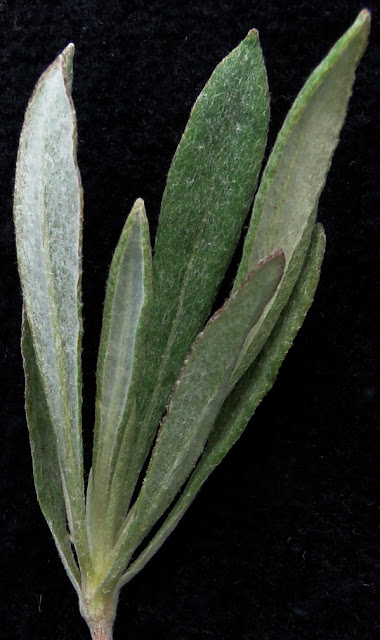































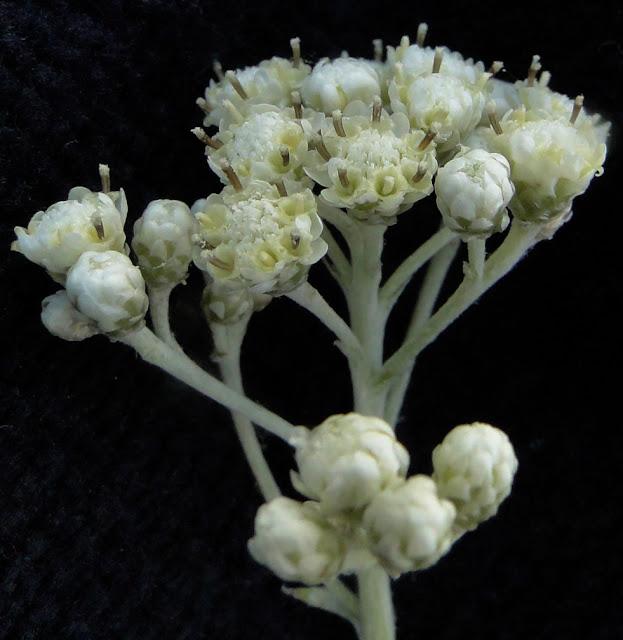
















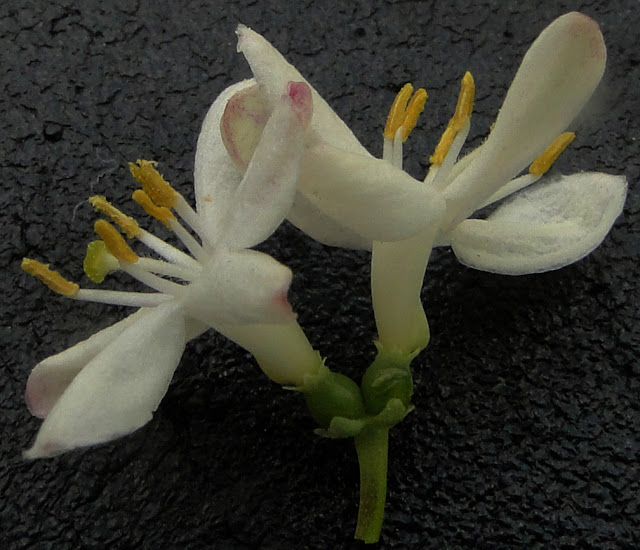
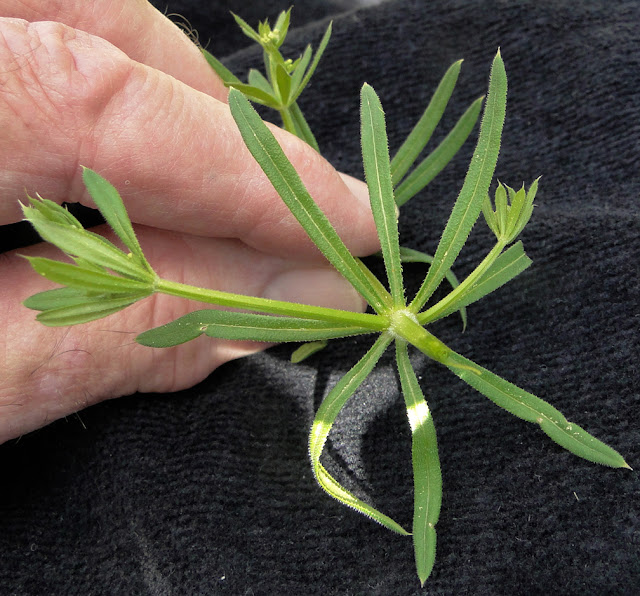


















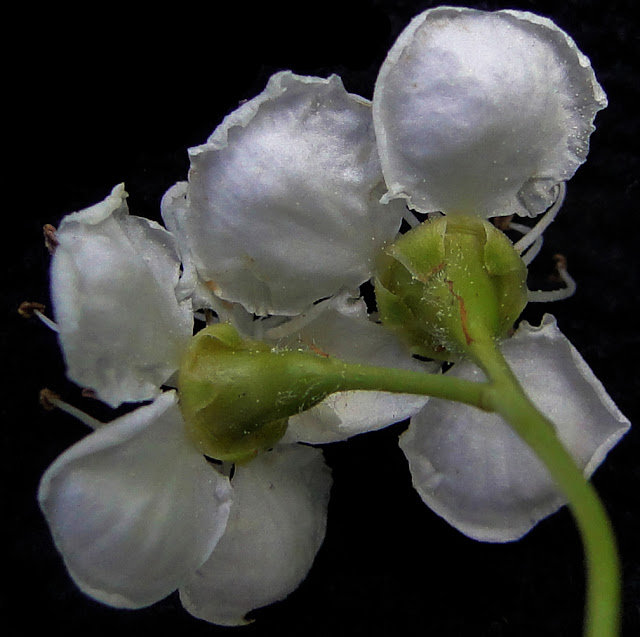


No comments:
Post a Comment